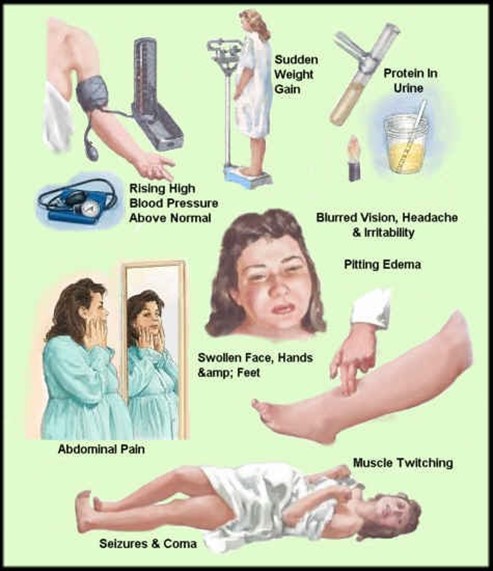A nurse is providing teaching to a client who is at 14 weeks of gestation about findings to report to the provider.
Which of the following findings should the nurse include in the teaching
Bleeding gums
Urinary frequency
preeclampsia
faintness upon rising
The Correct Answer is C
This is a sign of preeclampsia, a serious complication of pregnancy that can cause high blood pressure, proteinuria, and seizures.

Preeclampsia can affect the placenta, the kidneys, the liver, and the brain of the mother and the fetus. It requires immediate medical attention and may lead to early delivery.
Choice A, bleeding gums, is wrong because it is a common occurrence during pregnancy due to hormonal changes that increase blood flow to the gums. It is not a cause for concern unless it is excessive or accompanied by other symptoms.
Choice B, urinary frequency, is wrong because it is also a normal finding during pregnancy due to the growing uterus putting pressure on the bladder. It is not a sign of infection or kidney problems unless it is associated with pain, burning, or blood in the urine.
Choice D, faintness upon rising, is wrong because it is usually caused by orthostatic hypotension, a drop in blood pressure when changing positions.
This can happen during pregnancy due to the dilation of blood vessels and the increased blood volume. It can be prevented by rising slowly, drinking enough fluids, and avoiding prolonged standing.
Nursing Test Bank
Naxlex Comprehensive Predictor Exams
Related Questions
Correct Answer is D
Explanation
The correct answer is choice D. Administer analgesics on a scheduled basis for the first 24 hr.
This is because the child is at risk for developing peritonitis, which can cause severe abdominal pain.
Scheduled analgesics can provide better pain relief than PRN analgesics.
Choice A is wrong because the child should not be given anything by mouth until bowel sounds return, which can take up to 24 hr after surgery.
Giving clear liquids too soon can cause nausea, vomiting, and abdominal distension.
Choice B is wrong because cromolyn nebulized solution is used to prevent asthma attacks, not to treat appendicitis.
There is no indication that the child has asthma or needs this medication.
Choice C is wrong because applying a warm compress to the operative site can increase inflammation and infection risk.
A cold compress can be used to reduce swelling and pain, but only if prescribed by the provider.
Correct Answer is C
Explanation
The leader allows the group to discuss whatever they would like to regarding their medications.
This is because a laissez-faire leadership style is characterized by minimal guidance and direction from the leader, and maximum freedom and autonomy for the followers.
The leader does not impose any rules or expectations on the group, and lets them decide how to manage their own learning and behavior.
Choice A is wrong because having group members vote on what they would like to learn about during the session is an example of a democratic leadership style, not a laissez-faire one.
A democratic leader solicits input and feedback from the group, and makes decisions based on consensus and majority rule.
Choice B is wrong because lecturing about medication adverse effects to the group members is an example of an authoritarian leadership style, not a laissez-faire one.
An authoritarian leader dictates what the group should do and how they should do it, without considering their opinions or preferences.
Choice D is wrong because encouraging group members to remain silent until questions are called for is an example of a paternalistic leadership style, not a laissez-faire one.
A paternalistic leader treats the group as if they are incapable of making their own decisions, and assumes a protective and nurturing role over them.
Normal ranges for leadership styles are not applicable in this context, as different styles may be more or less effective depending on the situation and the goals of the group.
However, some general advantages and disadvantages of each style are:
- Laissez-faire: Advantages - fosters creativity, independence, and self-motivation; Disadvantages - may lead to chaos, confusion, and lack of accountability.
- Democratic: Advantages - promotes participation, collaboration, and satisfaction; Disadvantages - may be time-consuming, inefficient, and conflict-prone.
- Authoritarian: Advantages - provides clarity, direction, and control; Disadvantages - may cause resentment, resistance, and dependency.
- Paternalistic: Advantages - creates trust, loyalty, and commitment; Disadvantages - may inhibit growth, development, and empowerment.
Whether you are a student looking to ace your exams or a practicing nurse seeking to enhance your expertise , our nursing education contents will empower you with the confidence and competence to make a difference in the lives of patients and become a respected leader in the healthcare field.
Visit Naxlex, invest in your future and unlock endless possibilities with our unparalleled nursing education contents today
Report Wrong Answer on the Current Question
Do you disagree with the answer? If yes, what is your expected answer? Explain.
Kindly be descriptive with the issue you are facing.
